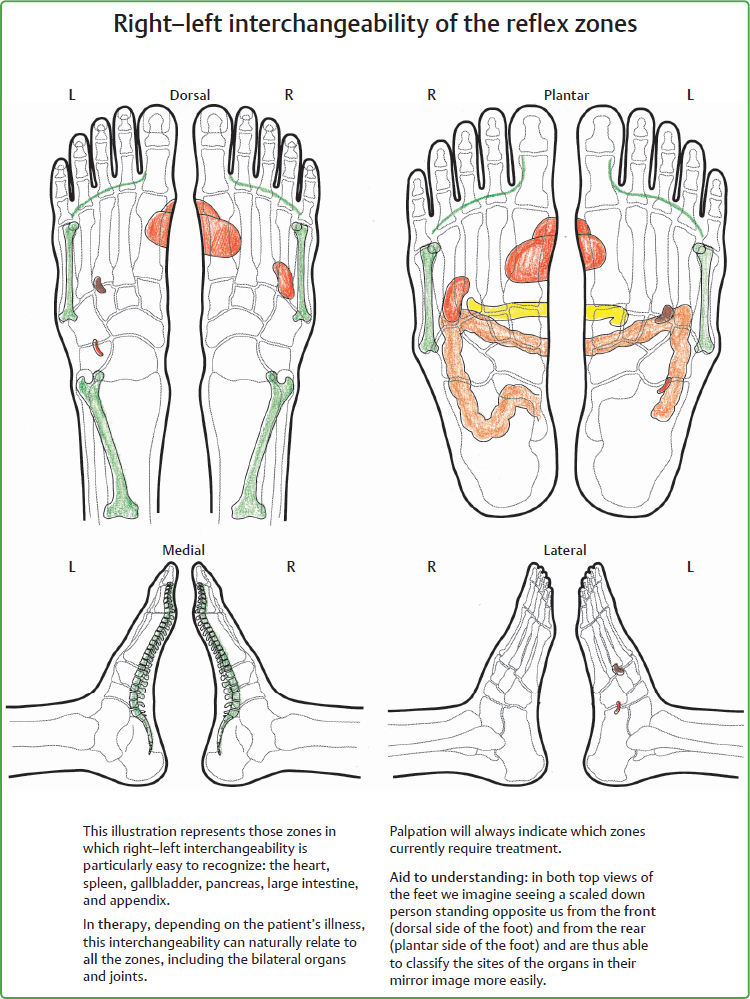15 Right–Left Interchangeability of Zones of the Feet For decades William FitzGerald’s assignment of body zones to the same side in the feet had for the most part proved its worth in my practice. Contrary to his findings, however, I repeatedly observed that in disorders and complaints in bilateral organs, joints, and groups of muscles the point on the foot which corresponded to the symptom-free side of the body reacted just as strongly to the treatment stimulus as the affected point, or even more strongly. Initially I assigned this to the principle of contralateral effects known to me from physical therapy (Chapter 18.4). Later, however, my observations of a right–left relationship of the areas affected by symptoms were confirmed by experienced doctors using acupuncture and neural therapy. In some patients I then gradually began to specifically treat only the side corresponding to the complaint-free side of the body in accordance with the previous assignment of zones; that is, I only treated the zone of the shoulder on the left foot, although there was a shoulder injury on the right. Sensitivity to pain at the newly selected points did not prove uniform but the results were striking enough to continue devoting much of my time to this. In the course of my observations over the years, I also began to examine the zones of the unilateral organs. For example, I observed that in some patients the point that corresponded to the gall bladder zone on the right foot reacted just as strongly or even more so on the left. Strangely, more than once acute biliary colic was triggered exclusively and spontaneously only as a result of treatment of the left foot. It was clear that the right–left reversal was present so often that I could not simply dismiss it as accidental. Wholly unexpectedly at first, course participants supported me for years by coming to further courses with their own, similar observations of the right–left reciprocal effect and for their part found their observations confirmed by my practical experiences. This background led me to extend the hitherto familiar and exclusive view held by FitzGerald of same-sided assignment to include the spectrum of right–left interchangeability of the zones. FitzGerald’s arrangement is retained in the detailed illustrations of the zones in this book, in other words: right half of the body, right foot. In addition to the illustrations of all the zones (Figs. 9.1–9.4), this chapter includes a slightly smaller drawing of the right–left reversal as important information, repeatedly confirmed in practice, in other words: right half of the body, left foot (Fig. 15.1) and vice versa. I should like to pass on these experiences and observations to stimulate the expansion of therapeutic approaches within reflexotherapy of the feet and do not regard them as a restrictive either/or principle. The right–left relationship should be considered as a possible variation in the treatment process in the very first assessment; above all, with regard to the symptomatic zones (Chapter 11). If we want to clarify the side on which the relevant zone can be found, at the start of each new treatment session we briefly examine the symptomatic zones on their anatomically corresponding side on both feet simultaneously. As a rule, we will obtain a response which accords with one of the following three statements, and the patient’s reaction will indicate unmistakably the right path to the area requiring treatment: • The zone on the same side is more sensitive to pain (FitzGerald’s rule). • The zone on the opposite side is more sensitive to pain (right–left interchangeability). • Both sides react equally or with only a slight difference in terms of the quality and quantity of pain experienced. It is important to examine both feet simultaneously because if examined in succession, the treatment of one side might have already influenced the as yet untouched side, thus falsifying the results.
15.1 General Information
15.2 Practical Aids for Differentiation
Musculoskeletal Key
Fastest Musculoskeletal Insight Engine









